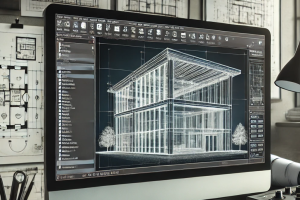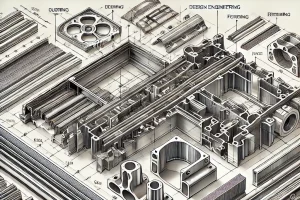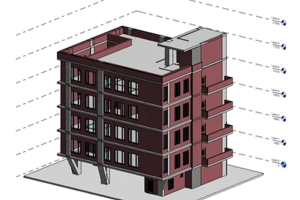The transition from sheet metal to aluminum extrusion design in automotive applications brings remarkable advantages in weight reduction, durability, and sustainability. Leveraging CAD tools allows engineers to streamline this process, ensuring that the resulting design not only meets performance standards but also capitalizes on aluminum’s unique properties. By following a structured conversion approach, automotive designers can innovate on the road to lighter, safer, and more fuel-efficient vehicles.
Blog Details

Converting Sheet Metal to Aluminum Extrusion Design for Automotive Applications
Introduction
The automotive industry continually seeks materials and designs that improve performance, reduce weight, and enhance fuel efficiency. Aluminum extrusions have emerged as a leading alternative due to their lightweight and strength properties, corrosion resistance, and recyclability. This blog will explore the process of converting traditional sheet metal designs to aluminum extrusion designs using CAD tools.
Why Switch from Sheet Metal to Aluminum Extrusion?
Scope of Work
Sheet metal is a reliable, cost-effective option that’s been used extensively in automotive structures. However, aluminum extrusions can deliver significant benefits in the automotive industry:
- Weight Reduction: Aluminum is lightweight yet strong, resulting in weight reduction that contributes to fuel efficiency.
- Corrosion Resistance: Aluminum offers excellent resistance to corrosion, reducing the need for protective coatings and extending component life.
- Energy Efficiency in Manufacturing: Extrusion processes can be energy-efficient compared to sheet metal stamping.
- Complex Geometries: Aluminum extrusion allows for complex, custom profiles that can be challenging to achieve with sheet metal.
Step-by-Step Guide to Conversion Using CAD Tools
- Analyzing the Existing Sheet Metal Design
Begin with a thorough analysis of the existing sheet metal design. Key factors to assess include:
- Geometry and Constraints: Identify the geometry of the current part, including bends, folds, holes, and attachment points.
- Structural Requirements: Evaluate the component’s load-bearing capacity, durability needs, and potential stress points.
- Functionality and Assembly Fit: Note how the part interacts with surrounding components and whether a design change could affect assembly fit and
CAD tools such as SolidWorks or AutoCAD can be used to create detailed 3D models of the original sheet metal part, facilitating a clear understanding of these requirements.
2. Selecting the Right Aluminum Alloy
Choosing the appropriate aluminum alloy is crucial since not all aluminum grades are suitable for extrusion or have the same mechanical properties. Commonly used automotive-grade alloys include:- 6061-T6: Offers a good balance of strength, weldability, and corrosion
- 6063: Known for its excellent finish and suitability for intricate
- 7005: High strength and used in structural components that demand greater load- bearing capacity.
CAD-integrated materials databases, like those in SolidWorks, Inventor, or Fusion 360, allow designers to select the correct alloy and visualize its properties in the digital model.
3. Redesigning for Extrusion
With aluminum extrusion, it’s possible to design complex cross-sectional shapes not feasible with sheet metal. Key redesign steps include:
- Simplifying Geometry: Consider transitioning folds, bends, and complex geometries to straight sections that match the extrusion die’s profile.
- Reducing Part Count: Combine parts when possible by redesigning them as a single extrusion, reducing the need for assembly and fasteners.
- Optimizing Wall Thickness: Adjust wall thickness for weight reduction without compromising CAD tools like Fusion 360 offer stress analysis simulations that can help determine optimal thickness based on load-bearing requirements.
4. Adding Necessary Features for Assembly and Attachment
Extruded aluminum designs often require post-extrusion machining to add holes, slots, or cutouts for assembly. Use CAD to model these features and ensure precise integration.
SolidWorks’ Hole Wizard and Feature Toolkits are useful for adding complex features like:
- Attachment Points: Add slots, tabs, or holes for bolting, riveting, or
- Interlocking Shapes: Design tongues and grooves for ease of assembly and secure fitment.
Simulations can further verify that these features won’t impact the part’s structural integrity.
5. Evaluating Structural Performance through Simulation
Once the design is complete, use CAD-integrated Finite Element Analysis (FEA) tools to evaluate the structural integrity of the new extrusion model. These simulations can reveal potential weak points, stress concentrations, and deformation risks under various loading conditions.
Key tools include:
- SolidWorks Simulation: Allows for linear and non-linear FEA on different
- ANSYS: Offers extensive structural analysis capabilities, including thermal and fatigue analysis.
With FEA, you can validate that the extrusion meets automotive safety and durability standards before moving to physical prototyping.
6. Cost Analysis and Tooling Setup
As extrusion tooling can be expensive, use your CAD design to estimate costs and check the design’s feasibility for mass production. Key steps include:
- Die Design & Costing: CAD tools like AutoCAD or SolidWorks can help design the extrusion
- Material Efficiency: Evaluate material yield to ensure minimum waste in
Some CAD tools have modules that integrate with costing software, allowing you to estimate production costs based on design parameters, alloy choice, and tooling complexity.
Benefits of CAD in Aluminum Extrusion Design
CAD tools streamline the conversion process by offering features like:
- Material Libraries: Preloaded aluminum alloy
- FEA and Simulation: For structural
- Die Design: Allows custom profiles to match application
- Costing Modules: Simplifies cost estimation based on material and
CAD-driven conversion from sheet metal to aluminum extrusion enables automotive engineers to optimize designs for performance, cost, and manufacturability, contributing to a more efficient, eco-friendly, and innovative automotive industry.
Conclusion
Recent Posts

Civil Design
Unlocking Efficiency with PDF to CAD Conversion in AEC Industry
Product Design
Converting Sheet Metal to Aluminum Extrusion Design for Automotive Applications
Civil Design
Architecture 3D Models with Revit BIM: Transforming Building Design and Construction
Civil Design
Building Information Modeling (BIM) and 3D Modeling with Revit Architecture: A Case StudyCategories
Have a project in mind?
Schedule a Call
Just One Call Away – Let’s Talk Solutions!
Call Us +91 7338189979
